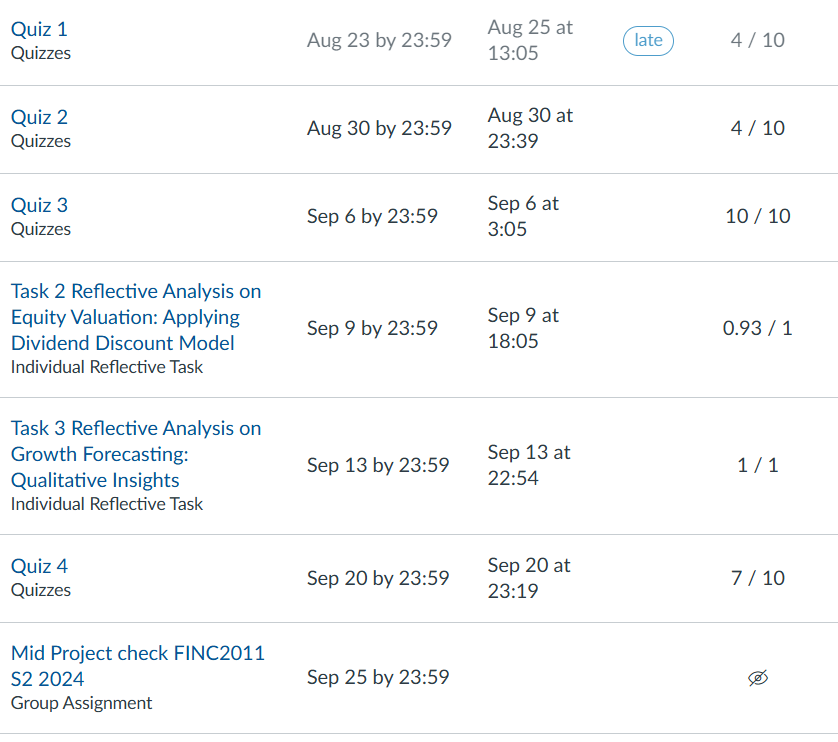FINC2011 solutions for Task 2 Reflective Analysis on Equity Valuation: Applying Dividend Discount Model
Task 2 Reflective Analysis on Equity Valuation: Applying Dividend Discount Model
marks (9月6号开始为四叶草代修)

Task Background:
Welcome to your individual reflective task 2. For this task, we continue to explore the practical applications of what you have learned.
In lecture and tutorial 5 - Equity Valuation, you learned to use the dividend discount model to estimate the intrinsic value of a stock. Then, in lecture 6, we discussed various dividend policies. This task is to help you to see how this can be applied in a real-life situation. All the quantitative analysis needs to start with data collection. In this task, you will explore where to find the relevant information and the data you need to perform a dividend discount model (DDM) analysis.
Task Description:
Let's keep working on Apple Inc.. Assume you want to evaluate the stock value of Apple Inc. (NASDAQGS: AAPL) using the Dividend Discount Model. You will need to find information on dividends, the discount rate, and growth rate(s). Assume you will only be assessing Apple's information from the year 2021 up to the financial year end of 2023 for your analysis. Please note that Apple's financial year-end is the end of September each year. Use the financial information that is publicly available from Apple to complete the following tasks:
Q1. Find Dividends
Find the dividend per share (DPS) and the dividend payout ratio (DPR) of Apple Inc. for the abovementioned period. List all the values and your calculation. Use the annual data for your analysis.
In 2-3 sentences, discuss any patterns you observe in the DPS or DPR, and explain how you would use either or both metrics to perform the DDM analysis.
Q2. Find Growth rate(s)
Find the earnings per share (EPS) in the company's financial statement and calculate the EPS growth rate. Briefly describe your method1.
Calculate the sustainable growth rate (
) and briefly describe your method2.
Compare the EPS growth rate with the sustainable growth rate, and in 2-3 sentences, discuss which one you would prefer for evaluating APPLE and why.
Q3. Find discount rate
In 2-3 sentences, discuss how you would estimate the discount rate (
) using the capital asset pricing model (CAPM). How would you find the necessary information to complete this calculation? You can utilise Google to find the relevant information online to support your discussion. Please reference the source of your information.
Q4. Apply the DDM
Based on your findings from questions 1-3 and your understanding of APPLE's financial performance, which DDM would you use for evaluating APPLE: a constant DDM, constant growth DDM, or a multi-stage DDM? Justify your choice in 2-3 sentences.
Footnotes:
1You will find there are many versions of EPS, and the most common two are Basic EPS and Diluted EPS. Basic EPS is calculated by dividing the net income of the company by the number of outstanding shares. It provides a direct measure of the earnings available to shareholders from the company’s operations. Diluted EPS extends basic EPS by including the impact of all potential shares that could be issued from securities like options or convertible bonds. For the purpose of this task, we want to keep the discussion simple, please refer to the Basic EPS for your analysis.
2Recall your knowledge from accounting, return on equity (ROE) can be calculated as
Marking Rubric:
In this task, you will be marked based on your
ability to accurately list the dividend information, utilise credible data sources and discuss your findings. (0.3/1 mark)
ability to calculate growth rates and critically evaluate the different methods used for their calculation. (0.4/1 mark)
ability to justify your preferred method for calculating the discount rate and discuss how you would source the necessary information for the calculation. (0.15/1 mark)
ability to select a realistic DDM and provide justification (0.15/1 mark)
You should include references to acknowledge the source of the data.
Task Resources - Researching Companies:
To find information related to a company, you could start by visiting the company's website. The website typically offers access to the company's annual report and financial statements. For instance, APPLE's investor centre https://investor.apple.com/investor-relations/default.aspxLinks to an external site. provides extensive information on the company's announcements, dividends, and policies and procedures. It is advisable to spend some time navigating through the tabs on this page to fully explore the available information.
For this task, you can start with the APPLE 2023 Annual Report 10k-Filling. Click HERELinks to an external site. to download. You can also find this document in the investor centre. The financial statement (Item 8) starts on page 30 of the document.
Alternatively, APPLE is listed on the NASDAQ exchange, you can also find the company's financial statement and announcements under NASDAQ's website https://www.nasdaq.com/market-activity/stocks/aapl/financialsLinks to an external site..
Please note there might be inconsistency in the data and ratio if you compare multiple sources, and that is common.
Many agencies and databases calculate ratios using their own metrics, which can lead to slight differences. It is recommended that you use the reported data directly from Apple and perform your own calculations for this task. This practice is designed to help you learn how to locate and understand the use of public data for company analysis. By handling real-world financial information directly, you’ll gain valuable experience crucial for effective company analysis.
You could also use the general search in the library to find books and journal articles if you are keen to include academic references at any stage of your research (this is not required for this reflective task).